BY LETTER
Extended World Classification System (EWoCS)
 Image from Dangerous Safety | |
| Extended World Classification System - Aerosols grouped by Thermal Class | |
The Extended World Classification System (EWoCS) is a multifactored system used to classify planets and other sub-stellar bodies according to numerous distinguishing features, such as their mass, temperature, composition and the detailed characteristics of their cloud coverings, liquid layers and orbital parameters. This classification system is partly derived from the still-widely used NoLWoCS scheme, and the ancient Sudarsky system, but includes many new planetary classes and types.
While the NoLWoCS is meant to give easy "at a glance" designations, the EWoCS gives a more in depth designation more useful for academia. Full EWoCS designations are notoriously long, and have been likened to ritual chanting. Because of this, full designations are rarely used, and instead several shortened variations exist to make maximum use of the modularity of the EWoCS.
Compositional Categories
The bulk composition of planets varies significantly, but the components are divided into several major groups; Gases (specifically Hydrogen and Helium) Volatiles (ices such as water, ammonia, solid nitrogen) Siderophilic elements (chiefly iron), and a wide range of atmospheric gases other than H/He. Also significant is the ratio between carbon and oxygen- worlds and systems that are oxygen-rich are dominated by oxidised rocks, while systems that are carbon-rich have more carbide-type minerals.Nebular Gas Fraction
Worlds categorised by H2/He content- Jovian: Gas Giant worlds. Hydrogen and helium make up more than 50% of these worlds by mass. Examples - Jupiter, Lipperhey, Maral
- Neptunian: Worlds with hydrogen and helium making up between 0.1% and 50% of the total mass. Examples - Neptune, Agraddi, Ruach
- Terrestrial: Worlds with less than 0.1% of the total mass coming from hydrogen or helium. Examples - Earth, Kudukha, Matow
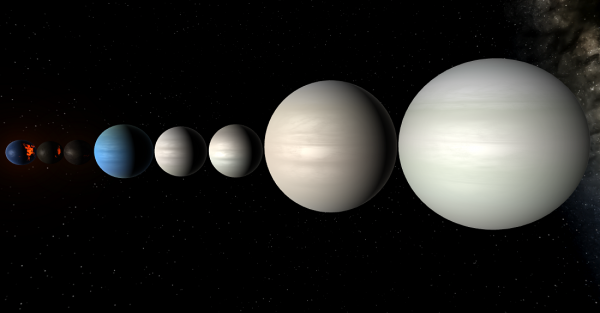 Image from Dangerous Safety | |
| Kepler 90, a system containing terrestrial, superterrestrial, neptunian and jovian worlds | |
Volatile Content
Worlds classified by their volatile content, sometimes referred to as ices (water, ammonia, carbon dioxide, methane, etc.)- Ymirian (prefix-Ymir): Volatile ices contribute more than 67% of the non-gaseous mass of these worlds. Examples - Rhea, Utmig, Sheol
- Gelidian (prefix-Geli): Mixed rock and ice composition. Volatiles make up 33-67% of the non-gaseous mass. Examples - Neptune, Ganymede, Blue
- Cerean (prefix-Cere): Volatiles make up 1-33% of their non-gaseous mass. Examples - Eris, Tartarus, Lifthrasir
- Lapidian (prefix-Lapi): Volatiles contribute less than 1% to the non-gaseous mass. Examples - Earth, Mendel, Simurgh
Carbon Content
Worlds classified by C/O (carbon to oxygen) ratio- Adamean (prefix-Ada): Worlds with enough excess carbon to form a graphite or diamond rich crust. C/O above 10 Example — Solaris
- Carbidic (prefix-Carbi): Worlds dominated by carbide minerals, with small amounts of carbonates. C/O ratio between 1 and 10. Examples - Janssen, Sisyphos, Tannhauser
- Carbonatic (prefix-Carbo): Worlds with a blend of carbonate, oxide, and carbide minerals. C/O ratio between 0.1 and 1. Examples - Jupiter, Konsheir, Nossad
- Oxidic (prefix-Oxy): Worlds dominated by oxide minerals and/or oxygen rich volatiles, C/O ratios less than 0.1. Examples - Earth, Venus, Embla
Siderophile Metal Content
Worlds classified by siderophile metal fraction. Often conflated with core fraction in rocky terrestrial worlds.- Ferrinian: Especially dense worlds with siderophile metals making up more than 80% of its non-volatile mass. These worlds are often coreless, or entirely core, depending on interpretation. Examples - Scott, Fujin
- Hermian: These worlds have siderophile metals making up 50-80% of their non-volatile mass. Examples - Mercury, Sacred Heart, Hermes
- Telluric: Worlds with siderophile metals making up 20-50% of the non-volatile mass. Examples - Earth, Eunna, Aphrodite
- Selenian: Siderophile metals make up 0-20% of the non-volatile mass. Examples - Luna, Nush, Thalia
Atmospheric Composition
Worlds categorised by atmospheric composition. Composition is measured at a standardized pressure of 1 bar, or the surface if pressures are below 1 bar, since atmospheric composition can vary with altitude at low and high pressures.- Jotunnian: Hydrogen-dominated atmosphere Examples - Saturn, Vert, Hyxuym
- Helian: Helium-dominated atmospheres Example - Kepler-10c, Kepler-20c, Rouge
- Ydratian: Atmospheres dominated by simple hydrides (CH4, NH3, H2O, HF) Examples - Senrau, Sarustre, Aphrodite
- Rhean: Atmospheres dominated by diatomic non-metals (N2, O2, F2) Examples - Earth, Espresso, Pluto
- Minervan: Atmospheres of other non-metal compounds (CO, CO2, SO2, NO2, HNO3, CS2, HCN) Examples - Venus, Io, Mars
- Hephaestian: Metal and metalloid compound atmosphere (SiO2, MgO, FeO, NaCl, Na, Fe) Examples - Janssen, Ixion
- Edelian: Atmospheres dominated by other noble gases Examples - Luna, Skeblu, Rashid
Aerosols
The appearance of worlds with thick atmospheres is mostly determined by the amount, composition, and distribution of its atmospheric aerosols, or lack thereof.The temperature of the troposphere, at ~0.1 bar, is also used to classify these worlds into four temperature categories: Cryothermal, <90 K; Mesothermal, 90-550 K; Pyrothermal, 550-1300 K; and Hyperpyrothermal, >1300 K. These temperature classes line up with late Y, early-mid Y, T, and L-M type brown dwarfs respectively.
Cryothermal Aerosols :: Less than 90 K
Cold worlds in the outer reaches of planetary systems and in deep space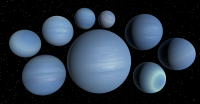 Image from Dangerous Safety | |
| CryoAzurian worlds | |
Examples - Uranus, Bayer, Azure
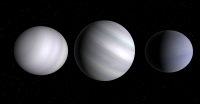 Image from Dangerous Safety | |
| Frigidian Worlds | |
Examples - Snowball
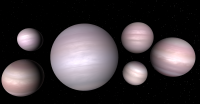 Image from Dangerous Safety | |
| Neonean worlds | |
Examples - Fenrir, Rouge
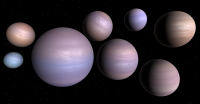 Image from Dangerous Safety | |
| Borean worlds | |
Examples - Violet, Halosa
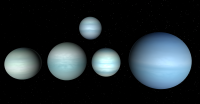 Image from Dangerous Safety | |
| Methanean worlds | |
Examples - Bergen, Tereshkova, Th'aa'ssoo
Mesothermal Aerosols :: 90-550 K
Worlds of intermediate temperatures and distances.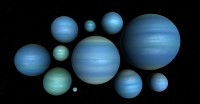 Image from Dangerous Safety | |
| MesoAzurian worlds | |
Examples - Vert, Senrau
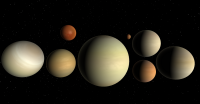 Image from Dangerous Safety | |
| Tholian Haze | |
Examples - Titan, Nidaba, Yaudel
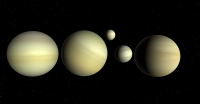 Image from Dangerous Safety | |
| Sulfanian worlds | |
Examples - Huraltis, Gagarin
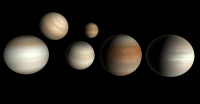 Image from Dangerous Safety | |
| Ammonian worlds | |
Examples - Saturn, Mesenti, Samael
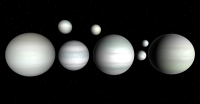 Image from Dangerous Safety | |
| Hydronian worlds | |
Examples - Earth, Athena, Harriot
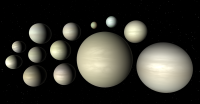 Image from Dangerous Safety | |
| Acidian worlds | |
Examples - Venus, Argent, Iolus
Pyrothermal Aerosols :: 550-1300 K
Hot worlds close to their star or still hot from forming.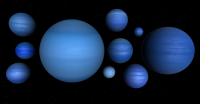 Image from Dangerous Safety | |
| PyroAzurian Worlds | |
Examples - Omonaum, Ides, Blueglass
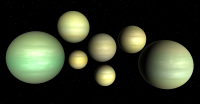 Image from Dangerous Safety | |
| Sulfolian Worlds | |
Examples - Gules, Steenbok, Hretha
Image from Dangerous Safety | |
| aithalian Worlds | |
Examples - Erebus, Galileo, Silefobran
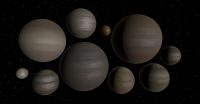 Image from Dangerous Safety | |
| Alkalinian worlds | |
Examples - Hogelun, Zynran, Fram
Hyperpyrothermal Aerosols :: Above 1300 K
Very hot worlds with nightsides luminous at visible wavelengths, making their natural color difficult to observe.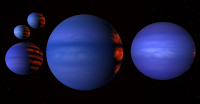 Image from Dangerous Safety | |
| Hyperpyroazurian worlds | |
Examples - Saffar, WASP-76b, KELT-9b
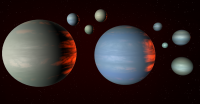 Image from Dangerous Safety | |
| Enstatian worlds | |
Examples - Dimidium, Kusuma, Janssen
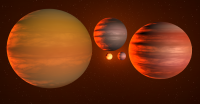 Image from Dangerous Safety | |
| Refractian worlds | |
Examples - Smertrios, HAT-P-7b
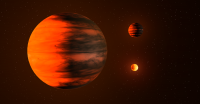 Image from Dangerous Safety | |
| Carbean worlds | |
Examples - WASP-12b
Surface and Subsurface Conditions
Also known as terrestrial types, as they are to only worlds to even have well defined surfaces. However Neptunian and Jovian worlds can also possess surface types.Surface Type
Worlds categorised by the phase transition at the boundary between their atmosphere and their topmost solid or liquid surface.- Abyssal: Worlds characterised by a high pressure compressible liquid surface under a thick, vapor rich, and often supercritical fluid atmosphere. Examples - Deep Red, Ides, Whernside
- Gaian: Worlds resembling Earth, with atmospheric vapor condensing into liquid lakes, seas, and oceans on the surface. Examples - Earth, Senrau, J'ha'sothaa
- Cytherean: Venus-like worlds characterised by a surface transition from a supercritical fluid to a distinct solid substrate. Like larger Neptunians and Jovians, the upper atmospheres of these worlds often host virga precipitation, which evaporates before reaching the surface. Examples - Venus, Hanjri, Omonaum
- Muspellian: Worlds where the supercritical fluid atmosphere transitions to high pressure ice at the surface. They are similar to Cytherean worlds. Muspellian worlds have crushing atmospheres, often in excess of 100,000 bar. Examples - Discoti, Surtr, Neptune
- Barian: Worlds with a high pressure metalized liquid under a supercritical fluid atmosphere. This type is limited to Neptunian and Jovian worlds, and metallic hydrogen is nearly universally the liquid medium. Examples - Jupiter, K'at'sa'thos'kul, Shiva
- Arean: Worlds characterised as having vapor atmospheres below the triple point where atmospheric vapor can deposit and sublime to and from the surface. Examples - Mars, Rashid, Compass
- Agonian: Worlds where a gaseous or vapor atmosphere above the triple pressure meets the surface without any liquids or supercritical fluids present. Examples - Lamarck, Daphnis
- Achlysian: Worlds with a gaseous or vapor atmospheres below the triple pressure, where there are no ices present on the surface. Examples - Pasteur, Little Gracia
- Apnean: Airless worlds with only an exosphere and surface pressures below 0.1 nanobar [10E-5 Pa]. Examples - Luna, Mercury
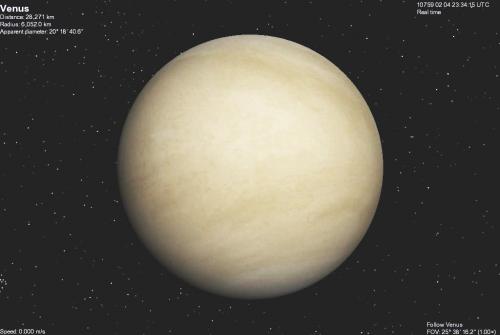 Image from Steve Bowers | |
| Venus, a Cytherean type world | |
Subsurface Type
Worlds categorised by phase transitions beneath the surface.- Europan: Worlds with a subglacial hydrosphere beneath a layer of solid ice. Examples - Europa, Eucleia, Barawatten
- Thalassic: Worlds with high pressure ices at the bottom of a liquid ocean. Examples - Panthalassa, Janssen, Euthenia
- Ganymedean: Icy worlds with high pressure ices at the bottom of a subglacial hydrosphere. Ganymedeans share features with both Europan and Thalassic worlds. Examples - Ganymede, Titan, Yaudel
- Phlegethean: Typically younger worlds with a supercritical fluid layer under a deep compressible liquid ocean. Examples - Henson
- Atlantean: Icy worlds with a supercritical fluid layer at the bottom of a subglacial hydrosphere. Combination of the Europan and Phlegethean classes. Examples - Atlas, Globe
- Cryptian: Worlds with a liquid hydrosphere in caverns and subsurface fluid tables beneath or within a distinct substrate. Examples - Labyrinth, Tierra del Fuego, Kaova
Precipitation Type
Worlds categorised by their precipitation and retention of surface ices.- Thermal: Worlds too hot for any frozen precipitation to reach the surface. Typically very humid. Examples - Tohul
- Tepidal: Temperatures low enough for snow and ice, but not for permanent accumulation in ice caps. Examples - Trees, Titan, Io
- Tundral: Worlds cold enough for snow and ice to accumulate in glaciers and ice caps, but still warm enough for rain. Examples - Earth, Mars, Pluto
- Glacial: Worlds where it is too cold for rain to occur. These worlds can still support liquids on the surface from warmer surface temperatures, though are usually covered in snow and ice. Examples - Matow
Liquid Surface Coverage
Worlds with surface liquids categorised by its coverage on the surface. This also includes liquid reservoirs that are covered by ice.- Inundic: The surface is entirely covered by liquids. Examples - Eunna, Lifthrasir
- Oceanic: 90-100% of the surface is covered by a liquid or its ice. Example - Pacifica
- Marine: Worlds where 60-90% of the surface is covered by a liquid, often as a single interconnected body. Examples - Earth, Johnson
- Estuarine: 40-60% of the surface is covered by a liquid. Examples - Tohul, Fasetuvastas
- Lacustrine: 10-40% of the surface is covered by a liquid, often as shallow isolated bodies. Examples - Samael, Macrystis
- Conlectic: Less than 10% of the world's surface is covered by a liquid. Examples - Titan, Nossad
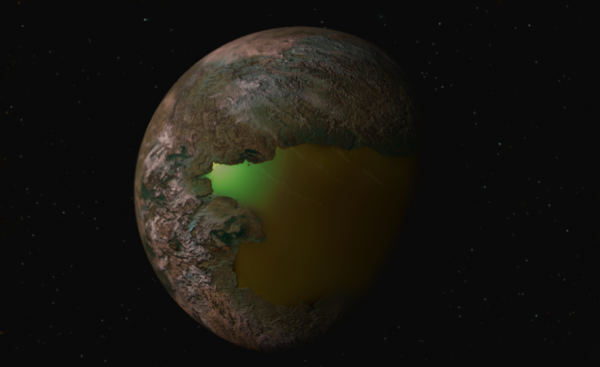 Image from Steve Bowers | |
| The ammonia seas of Samael | |
Fluids and Ice Types
There are countless different fluids that can be naturally found on worlds, though only a few of these are relatively common.Hydrospheres are unique among these in that they can be near homogeneous mixtures of multiple fluids, unlike the more stratified layers in ices and supercritical fluids. For Gaian, Tohulian, Europan, and Cryptian worlds, if a secondary fluid type comprises more than 5% of the total, then a hybrid fluid type is used. Examples - Tytalus (ChloroAquaGaian), Samael (AmuAquaGaian)
- Aquatic (prefix-Aqua): Water. Usually found as a liquid or supercritical fluid, water is one of the most common fluids. Because of its abundance, it usually dominates binary liquid mixtures with other liquids. Liquid water is usually blue in color.
- Amunian (prefix-Amu): Ammonia. A common fluid, it typically occurs as a liquid, usually in conjunction with water at low to moderate concentrations. Ammonia dominated liquids, as well as ammonia ices, are less frequent.
- Titanian (prefix-Titano): Short hydrocarbons, most commonly methane, ethane, and/or propane, with other organic compounds in lesser amounts. It is a very common fluid type, predominantly occurring as a liquid, but can also occur as ices. Nitrogen and carbon monoxide, slightly colder liquids, are capable of mixing with titanian seas.
- Petrolic (prefix-Petro): Moderate length hydrocarbons with a composition comparable to crude oil, containing the alkanes pentane to icosane along with a wide variety of other organic compounds. The petrolic fluid type is rather common, especially on, but not limited to, carbon rich worlds. Because of the overlapping liquid ranges and low triple points of its constituents, nearly all petrolic worlds are host to liquids. Petrolic worlds are similar to Titanian worlds, but occur at higher temperatures.
- Bitumic (prefix-Bitu): Bitumen and other heavy organic compounds. A common fluid type that usually occurs as either a liquid or supercritical fluid, as a result of the low critical pressure of long hydrocarbons. These worlds are similar to Petrolic worlds, but occur at even higher temperatures. They can be found with varying levels of sulfur and organosulfur compounds.
- Dionysian (prefix-Diono): Alcohols, primarily methanol and ethanol. A fairly common fluid type, that usually occurs as a liquid. Alcohols are miscible with many substances, like water, octane, and carbon disulfide.
- Capnian (prefix-Capno): Carbon dioxide. It usually occurs as a supercritical fluid or as an ice, and is one of the most common fluid types.
- Azotian (prefix-Azo): Nitrogen. It is one of the most common fluids, typically found as an ice or supercritical fluid. The Azotian type is quite ubiquitous among cold outer system worlds beyond the N2 iceline, as well as cytherean worlds with thinner atmospheres.
- Monoxian (prefix-Monoxo): Carbon monoxide. A somewhat common fluid that is usually found as either an ice or supercritical fluid. It occurs in similar conditions to nitrogen, but as it is prone to oxidation, it is limited to more carbon rich worlds.
- Oxygenean (prefix-Oxygo): Oxygen. A less common fluid type, found almost exclusively as a supercritical fluid. These conditions occur on worlds that have lost extreme amounts of water.
- Hydrogenean (prefix-Hydrogo): Hydrogen. A very common fluid, typically as a metallic liquid in Neptunian and Jovians, but can also much less frequently occur on large cold terrestrials in other states, usually a supercritical fluid. Liquid hydrogen is very rare, as ambient interstellar temperatures and internal heating can make a world too warm for hydrogen to condense onto the surface.
- Neonic (prefix-Neono): Neon. A somewhat uncommon fluid typically found as an ice, supercritical fluid, or occasionally a liquid. It is most frequent on interstellar objects, where internal heating alone is sufficient to keep it from becoming part of the substrate.
- Ignean (prefix-Igneo): Magma, primarily in the form of molten metals, metal oxides, and metal carbides. One of the most common fluid types, but is often limited to the interiors of worlds. It most frequently occurs as a liquid.
- Salific (prefix-Salifo): Metal salts, primarily alkali chlorides and sulfates. A rare fluid, that usually occurs as either a liquid or ice. They are usually found alongside other metal compounds like lower temperature magmas and sulfur compounds.
- Fortic (prefix-Forto): Nitric acid. A very uncommon fluid type, primarily as a liquid. Nitric acid is often found in solution with water, but also occasionally ammonia or dinitrogen tetroxide. It is rarely found in concentrations above around 70%.
- Amylian (prefix-Amy): Oxides of nitrogen, primarily nitrogen dioxide and dinitrogen tetroxide. A rare fluid type, usually found as an ice or liquid. Will combine with water to form nitric acid.
- Cyanic (prefix-Cyano): Hydrogen cyanide. An uncommon fluid, usually found as either a liquid or ice. It occurs in similar, albeit slightly warmer, environments to ammonia, which it often occurs alongside. It is more common in carbon rich systems.
- Hepatic (prefix-Hepa): Hydrogen sulfide. An uncommon fluid, usually found as a liquid or ice. When liquid, it often occurs in combination with ammonia or water.
- Ionean (prefix-Io): Oxides of sulfur, predominantly sulfur dioxide. An uncommon fluid that occurs most often as an ice or liquid, but is also rarely found as a supercritical fluid. The IoArean type is especially common for cold volcanic worlds.
- Disulfian (prefix-Disulfa): Carbon disulfide. A rather uncommon fluid type, usually as a liquid. Most commonly found on carbon rich volcanic worlds, and can occur alongside a wide array of compounds.
- Brimstonian (prefix-Brimo): Sulfur. An uncommon fluid, typically occurring as a liquid or ice. Typically occur on hot volcanic worlds enriched in sulfur. It can be found with organosulfur compounds and metal sulfides.
- Vitriolic (prefix-Vitrio): Sulfuric acid. An uncommon fluid that usually occurs only as a liquid. Higher concentrations are somewhat more common than lower ones, as a result of azeotropic mixing with water. In addition to water, sulfuric acid can also occur alongside sulfur oxides, and more rarely phosphoric or hydrochloric acid.
- Carbonylic (prefix-Carbonylo): Metal carbonyls, primarily iron pentacarbonyl or nickel tetracarbonyl. A very uncommon fluid that is typically found as a liquid. Most often occurs on worlds with metal rich surfaces, and is sometimes in solution with petrochemicals or alcohol.
- Formamian (prefix-Forma): Formamide and other simple organic compounds containing hydrogen, carbon, nitrogen, and oxygen. Formamide is an uncommon fluid, usually in a liquid state. It is usually found along various organic and inorganic compounds, including water, ammonia, alcohols, hydrogen cyanide, and formic acid.
- Phosphinic (prefix-Phosphi): Phosphine. A very rare fluid usually found as a liquid or ice. It often occurs in solution with alcohol or carbon disulfide.
- Phosphoric (prefix-Phospho): Phosphoric acid. A very rare fluid type usually found as a liquid or ice. It can be found alongside water or sulfuric acid with similar frequencies.
- Hydrochloric (prefix-Chloro): Hydrochloric acid or hydrogen chloride. A very rare fluid, primarily a liquid. It is readily formed from sulfuric acid breaking down chloride minerals, and usually occurs alongside H2SO4. It can also form from biological processes, though more rarely. Highly concentrated hydrogen chloride is far rarer than lower concentrations.
- Hydrofluoric (prefix-Fluoro): Hydrofluoric acid or hydrogen fluoride. An extremely rare fluid type. These worlds form through similar mechanisms to hydrochloric worlds, but are far rarer due to fluorine's lower abundance.
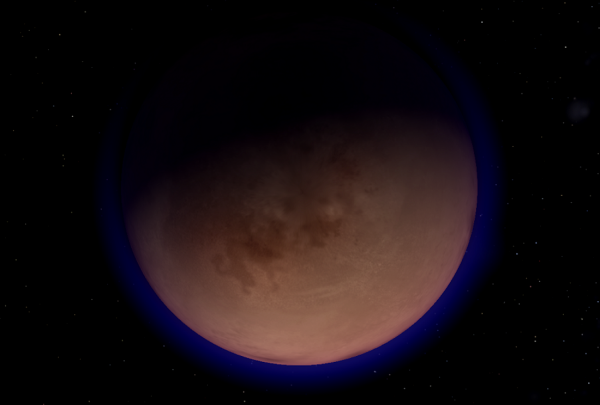 Image from Steve Bowers | |
| The ethane seas of Titan | |
Mass
A single unified mass scale for all objects, regardless of their composition.Planetesimals :: Small irregular bodies
- Lowerplanetesimal: 2.4E+11 to 2.4E+13 kg. Small objects just massive enough to not be affected by gas drag. Examples - 67P/CG, Braille, Ryugu
- Midplantesimal: 2.4E+13 to 2.4E+15 kg. More likely to be a singular object rather than aggregate rubble pile. Examples - Deimos, 1P/Halley, Daphnis
- Upperplanetesimal: 2.4E+15 to 2.4E+17 kg. Largest bodies unable to undergo partial differentiation. Examples - Pandora, Metis, Phobos
Planetoids :: Small semi-rounded bodies
- Lowerplanetoid: 2.4E+17 to 2.4E+18 kg. May have possibly undergone partial differentiation in its past. Examples - Amalthea, Elara, Epimetheus
- Midplanetoid: 2.4E+18 to 2.4E+19 kg. May be semi-rounded in appearance from past hydrostatic equilibrium. Examples - Psyche, Phoebe, Hyperion
- Upperplanetoid: 2.4E+19 to 2.4E+20 kg. Can potentially maintain a rounded shape after falling out of hydrostatic equilibrium. Examples - Hygeia, Proteus, Mimas
Terrenes :: Medium rounded bodies
- Petiterrene: 0.00004 to 0.0004 Earth masses. Massive enough to likely remain in hydrostatic equilibrium. Examples - Quaoar, Ceres, Vesta
- Lowerterrene: 0.0004 to 0.004 mE: Examples - Triton, Pluto, Haumea
- Midterrene: 0.004 to 0.04 Earth masses. Likely to be fully differentiated. Examples - Ganymede, Luna, Europa
- Upperterrene: 0.04 to 0.4 Earth masses. May be tectonically active for hundreds of millions to billions of years before becoming quiescent. Examples - Yaudel, Mars, Mercury
- Grandterrene: 0.4 to 4 Earth masses. Capable of supporting mobile-lid tectonics and unable to completely lose an atmosphere under extreme heating. Examples - Phobetor, Earth, Venus
Giants :: Large rounded bodies
- Lowergiant: 4 to 40 Earth masses. Massive enough to develop a thick hydrogen and helium envelope, which may be lost or greatly reduced after formation from high temperatures. Examples - Vert, Uranus, Janssen
- Midgiant: 40 to 400 Earth masses. May have undergone runaway accretion in its past. Examples - Jupiter, Smertrios, Brahe
- Uppergiant: 400 to 4000 Earth masses. Largest giants unable to undergo deuterium burning. Radius is only minimally affected by mass. Examples - Majriti, Lipperhey, Quijote
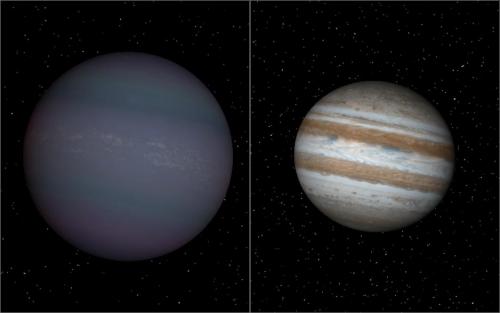 Image from Steve Bowers | |
| Hat-P-1b and Jupiter, a midgiant world and an uppergiant world | |
Miscellaneous Parameters
Some worlds can have peculiar characteristics which do not fall into any of the other categories. These characteristics are denoted here.Rotation Based Classifications
Worlds with unusual rotational parameters.- Skolian: High Obliquity worlds with an axial tilt between 45 and 135 degrees, resulting in polar regions having a higher average temperature than the equator. Example - Uranus
- Videntian: Worlds tidally locked to their primary. This includes most moons. Examples - Twilight, Raphael, Macrystis
- Stilbonian: Worlds in a spin orbit resonance with their primary, with an integer ratio between orbital and rotational period. Examples - Mercury, Ask, Duxed
- Aeolian: Fast spinning oblate worlds with a flatness of 0.1 or higher. Example - Mollweide
- Jacobian: Worlds which spin fast enough to relax into a triaxial Jacobi ellipsoid. Example - Haumea
- Synestian: Rapidly rotating worlds with an extended toroidal atmosphere, often briefly forming as a result of planetary collisions.
Orbital Classifications
Worlds with unusual orbital parameters.- Stevensonian Type Worlds: Worlds in interplanetary space that orbit a galaxy or cluster of stars directly. Example - Slippery Dave
- Ikarian Type Worlds: Worlds with highly eccentric orbits, with eccentricities of 0.35 or greater. Example - Perdix
- Circumbinary Type(s) Worlds: Worlds that orbit multiple stars in a system. Example - Mappa
Life Based Classifications
Worlds that currently host life, have previously hosted life, or are in the process of abiogenesis.- Protobiotic: Worlds undergoing abiogenesis, rich in prebiotic molecules like protocells and other life-like organisms. Usually only a brief phase, but may become greatly extended by various planetary factors. Example - Big Bob
- Microbiotic: Most common type of biotic world. These worlds host microbial life, often of low complexity. Example - Donbetyr
- Mesobiotic: Worlds with simple colonial, multicellular, and/or megacellular organisms. Example - Lontis
- Macrobiotic: Worlds hosting a well developed ecosystem of macroscopic multicellular, colonial, and/or megacellular organisms. Example - Trees
- Neobiotic: Worlds that have had life introduced from another world or heavily modified by artificial means. Example - Nova Terra
- Postbiotic: Worlds that had once hosted life which has since completely died out. Example - Hutamah
Planetary History Classifications
Worlds in unique or otherwise notable stages of their formation or evolution.- Chthonian: Worlds that formed with and since lost extensive hydrogen and helium envelopes. Examples - Janssen, Sisyphos
- Ragnorokian: Worlds that have survived their host star becoming a stellar remnant. Example - Tereshkova
- Odyssian: Worlds which originated in a different star system. Example - Unicorn
- Phoenixian: Worlds that formed around non-main sequence stars. Example - Poltergeist
- Chaotian: A world still immersed in a protoplanetary disk.
- Genesian: Artificially created planets and planet-like objects. Examples - Honour, Chartreuse
Multiworld Classifications
Worlds that have interesting orbital interactions with other worlds.- Trojan: Worlds orbiting at the L4 or L5 lagrange point of another world. This is only possible if the mass of the parent body is greater than 25 times that of the larger world.
- Janusian: Worlds that are in co-orbital resonance with another world where momentum exchange occurs regularly. Example Ayao and Oya
- Satellite: Worlds that orbit another world, rather than a star itself. Example - Luna
- Dioscuran: Worlds orbiting another world (or another pair) which has combined mass between 0.04 and 25 times its mass. Example - Pluto-Charon, Lempo-Hiisi-Paha.
- Rochean: Dioscuran worlds that share a common envelope. These worlds are often of very similar masses and may form contact-binaries. Example - Harmonic-Resonance;.
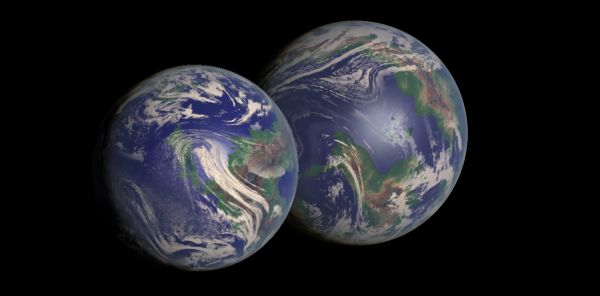 Image from Steve Bowers | |
| Laurel and Hardy, binary (Dioscuran) worlds | |
See Also
Artificial WorldsArtificial Planets
Megastructure Classification Systems
Related Articles
Appears in Topics
Development Notes
Text by Dangerous Safety
Additional material by Steve Bowers, The Astronomer, Quantum Jack, siliconprophet, Radtech497, based on the original PCL by John M. Dollan
Initially published on 18 March 2020.
Updated November 2020 by Dangerous Safety.
Added more links to named worlds January 2023.
2024-07-14 by The Astronomer to correct a factual error: Trojans are stable as long as the mass of the secondary body is lower than 1/25 of the primary body. (The exact situation appears to be fairly complex, but this is a rule of thumb.)
Tohulian surface type removed by ProxCenBound after discussion with Dangerous Safety and others, 2024-07-14.
2024-07-19 by The Astronomer to update definition of Dioscurans to use an objective definition.
Additional material by Steve Bowers, The Astronomer, Quantum Jack, siliconprophet, Radtech497, based on the original PCL by John M. Dollan
Initially published on 18 March 2020.
Updated November 2020 by Dangerous Safety.
Added more links to named worlds January 2023.
2024-07-14 by The Astronomer to correct a factual error: Trojans are stable as long as the mass of the secondary body is lower than 1/25 of the primary body. (The exact situation appears to be fairly complex, but this is a rule of thumb.)
Tohulian surface type removed by ProxCenBound after discussion with Dangerous Safety and others, 2024-07-14.
2024-07-19 by The Astronomer to update definition of Dioscurans to use an objective definition.
Additional Information
A Google docs spreadsheet showing more details about the EWoCS classification system,
by Dangerous Safety
by Dangerous Safety






